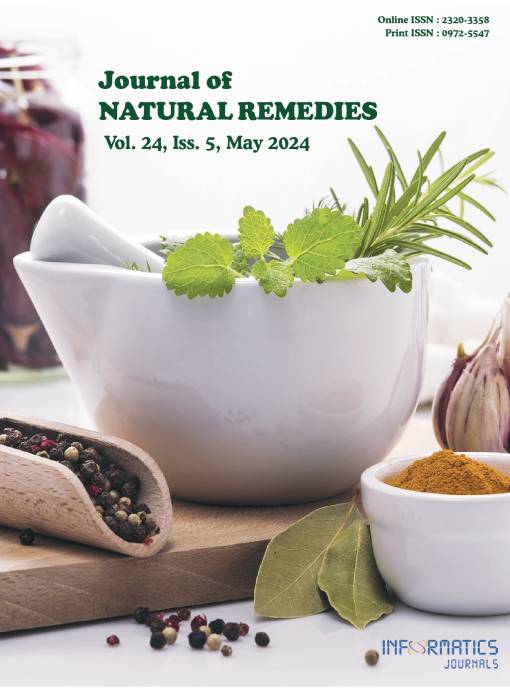Pharmacognostic and Phytochemical Evaluation of Staminate Flower of Cocos nucifera L
DOI:
https://doi.org/10.18311/jnr/2024/33215Keywords:
Coconut, Cocos nucifera, Narikela Flower, StandardisationAbstract
Background: Despite the medicinal value of the staminate flower of coconut (Cocos nucifera L) there is no data available in the archives for botanical as well as chemical standardisation of flowers of C. nucifera. Aim: Pharmacognostic characters and a phytochemical parameter can be used as a quality standard for authentication of the flower of C. nucifera and detection of adulteration. Methods: Pharmacognostic and phytochemical standardisation of the staminate flower of Cocos nucifera L. was performed as per Ayurvedic Pharmacopoeia of India. It includes studies like morpho-anatomical, powder analysis, preliminary phytochemical evaluation and HPTLC fingerprinting of the flower of C. nucifera. The solvent system in HPTLC studies was Toluene: Chloroform: Ethanol (4:4:1 v/v/v) powder analysis, histochemical test, and preliminary and phytochemical screening were carried out as per standard protocol. Results: Microscopic studies of petal sepals and anther show distinct characteristics that help in the evaluation of the genuine quality of flowers. Physicochemical parameters like loss on drying, total ash, and acid insoluble ash should not be more than 5.58%, 6.8061% and 0.223% respectively. However, water-soluble and alcohol-soluble extractives should not be more than 12.544% and 2.498% respectively. Six prominent bonds of Rf value (0.12, 0.37, 0.48, 0.52, 0.67 and 0.91) were visualised. This Rf value imparts significant quality control data in chromatographic (HPTLC) fingerprinting. Conclusion: Current findings will be helpful in plant authentication, assurance of quality and adulteration detection for staminate flower of C. nucifera.
Downloads
Metrics
Downloads
Published
How to Cite
Issue
Section
License
Copyright (c) 2024 Shyam Baboo Prasad, Snehal Gaikwad, Arun M. Gurav, Anupam K. Mangal, Shiddamallayya Nagayya, Venkateshwarlu Bandi, Narayanam Srikanth, Rabinarayan Acharya (Author)

This work is licensed under a Creative Commons Attribution 4.0 International License.
Accepted 2024-02-26
Published 2024-05-01
References
Chan E, Elevitch CR. Cocos nucifera (coconut). Species profiles for Pacific Island agroforestry. 2006; 2:1-27. https://raskisimani.files.wordpress.com/2013/01/cocos-nucifera-coconut.pdf
Francis JK. Naturalised exotic tree species in Puerto Rico. US Department of Agriculture, Forest Service, Southern Forest Experiment Station 1991. p. 12. https://www.fs. usda.gov/treesearch/pubs/1753. https://doi.org/10.2737/SO-GTR-82
Orwa C, Mutua A, Kindt R, Jamnadass R, Simons A. Agroforestree Database: A tree reference and selection guide. Version 4.0. 2009. http://www.worldagroforestry. org/af/treedb/ https://indiabiodiversity.org/species/show/229222
Bhandary MJ, Chandrashekar KR, Kaveriappa KM. Medical ethnobotany of the siddis of Uttara Kannada district, Karnataka, India. J Ethnopharmacol. 1995; 47(3):149-58. https://doi.org/10.1016/0378-8741(95)01274-H PMid: 8569239.
Renjith RS, Chikku AM, Rajamohan T. Cytoprotective, antihyperglycemic and phytochemical properties of Cocos nucifera (L.) inflorescence. Asian Pacific J Tropical Med. 2013; 6(10):804-10. https://doi.org/10.1016/S1995-7645(13)60142-X PMid:23870470.
Renjith RS, Rajamohan T. Protective and curative effects of Cocos nucifera inflorescence on alloxan-induced pancreatic cytotoxicity in rats. Indian J pharmacol. 2012; 44(5):555-9. https://doi.org/10.4103/0253-7613.100368. PMid:23112412 PMCid: PMC3480783.
Renjith RS, Rajamohan T. Young inflorescence of Cocos nucifera contributes to the improvement of glucose homeostasis and antioxidant status in diabetic rats. Int J Diabetes Dev Ctries. 2012; 32:193-8. https://doi.org/10.1007/s13410-012-0088-9.
Ahuja SC, Ahuja U, Ahuja S. Coconut-history, uses and folklore. Asian Agri-History. 2014; 18(3):221-48. https://doi.org/10.1016/B978-0-12-411645-0.00001-8. PMCid: PMC4037256.
Prasad SB, Sharma A. Standardisation of convolvulus pluricaulis choisy herbs collected from Jalandhar, Punjab. Int J Pharmacog Phytochem Res. 2016; 8:1412-16.
Sharma M, Chopra S, Prasad SB. Guazuma tomentosa: A valuable medicinal plant. Int J Pharmacog Phytochem Res. 2015; 71:197-200.
Kumari TJ, Pratap GP, Prasad SB, Murthy P, Prasad GP. Standardisation of balamula churna (Sida cordifolia L. root powder). Int J Curr Pharm Res. 2019; 15:27-30. https://doi.org/10.22159/ijcpr.2019v11i5.35697
Nirawane RB, Prasad SB, Kumar S, Gurav AM, Rao G, Prasad GP, Mangal AK. Pharmacognostic evaluation of root of Albizia lebbeck (Linn.) Benth. Int J Pharmacog Phytochem Res. 2018; 10(5):229-34.
Mangal AK, Tomer R, Jindal H, Prasad SB, Sharma H, Sharma BS, Srikanth N, Dhiman KS. Development and standardisation of Chaturbhadra Kvath Churna: An Ayurvedic Formulation. J Drug Res Ayurvedic Sci. 2019; 4(4):192-8.https://doi.org/10.5005/jdras-10059-0090
Anonymous, The Ayurvedic Pharmacopoeia of India, Part I, Vol IV, Appendix-2, (Ministry of Health and Family Welfare, Department of Ayurveda, Yoga and Naturopathy, Unani, Siddha and Homeopathy (AYUSH), Govt. of India, New Delhi), 2004; 152-74.
Prasad SB, Kaur D. In vitro Anti-acne activity of Ethanolic extract of stem of Berberis aristata. International H J Pharmacog Phytochem Res. 2017; 9:190-2. https://doi.org/10.25258/phyto.v9i2.8061
Mangal AK, Tomer R, Jindal H, Dahiya J, Prasad SB, Singh H, Sharma BS, Srikanth N. Development of quality control parameters for classical ayurvedic formulation: Vyoshadi Churna. J Ayurveda. 2023; 17(1):38-44. https://doi.org/10.4103/joa.joa_318_21

 Shyam Baboo Prasad
Shyam Baboo Prasad









 0.35
0.35 24
24 0.161
0.161